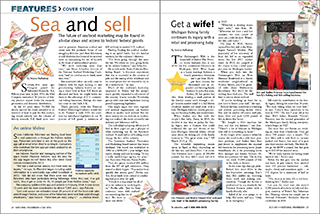Sea and sell
The future of seafood marketing may be found in all-star ideas and access to historic federal grants
By Jessica Hathaway
Seventy-five years ago, Congress passed the Saltonstall-Kennedy Act. Fifteen years later, in July 1954, the 83rd Congress earmarked 30 percent of fishery product import duties for research, promotion and domestic distribution.
In the 60 years since, NOAA has slowly moved the funds intended to be reserved at least in part for fish marketing almost entirely into the column of fishery research. S-K funds were once used to promote American seafood and create new fish products. Some of our struggling fisheries (and their fishermen) would doubtless fare better if we invested more in maximizing the use of bycatch in the form of underutilized species.
 "We need marketing more than ever," says Bruce Schactler, director of the National Seafood Marketing Coalition, "and we need access to funds more than ever."
"We need marketing more than ever," says Bruce Schactler, director of the National Seafood Marketing Coalition, "and we need access to funds more than ever."
But innovative ideas can only come to fruition with the right backing — and greenbacking. Industry leaders are taking a closer look at how S-K funds are allocated and how we might better use them to the advantage of U.S. commercial fishing businesses. Perhaps the time has come to take back S-K.
That's precisely what the National Seafood Marketing Coalition would like to do. Formed in early 2010, the coalition has introduced legislation to use 20 percent of S-K grants (a minimum of $20 million) to market U.S. seafood.
Finding funding for seafood marketing is an uphill battle, but it's familiar territory for the coalition's director.
"I've been going through this since the late '90s when we were going broke in the salmon business," says Schactler.
He served on the Alaska Fisheries Marketing Board, "a five-year experiment that was so successful in the creation of jobs and the raising of the wholesale and ex-vessel prices that we wanted to try to do it nationwide," he says.
Much of the coalition's leadership originated in Alaska, but the group's reach quickly expanded to all corners of the country. It now includes 78 industry groups with nine state legislatures having passed supporting legislation.
One might argue that state, regional and national organizations can fracture efforts to market local seafood. But the more money we can dedicate to marketing our seafood, the more successful our industry and fishermen will be.
The individual and group efforts you'll find in these pages are just a glimpse of what marketing can do for American seafood. A small influx of funding could change ...
Read the full article starting on page 20 of our July issue.
Find other National Fisherman articles discussing seafood marketing here.







